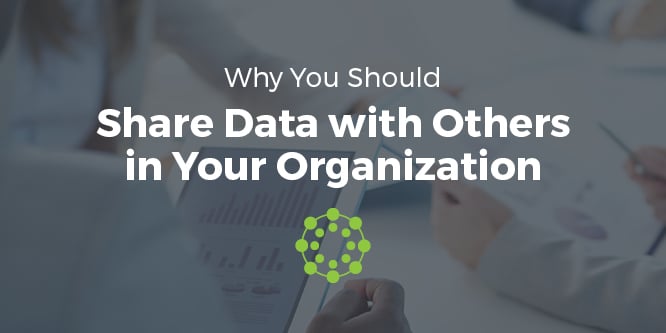Data, proper analytics, and related reports are crucial for making good business decisions in today’s world. But even the most actionable and remarkably useful data is a waste if the proper parties are not making use of it. Particularly when it comes to separate departments and decision makers, if they never see relevant data, then the investment made to collect the data is wasted dollars.
Just think about how much goes to waste if the data is forgotten or left to rot. Managing and sharing data in an organization increases the ways it is analyzed as well as increases its value. The same data set can provide different insights for different people across several organizational departments. For that reason alone, the benefits of information sharing are almost incalculable.
There are many reasons why the data might not make it to the appropriate parties. Maybe they don’t know it exists. Maybe they don’t have access to the systems and data management platforms you do. It’s possible they don’t even have the time to look over data in its raw, unfiltered form.
One department or internal team might have a completely different use for datasets, after interpreting it for their own work and responsibilities. For example, they might be able to extract completely different insights that are either just as useful or more so, in the context of their work. Financial and accounting departments may look at performance and sales data and see a way to cut-back spending, while the product development team may see an opportunity to improve existing products or services. But that will never happen if they’re not seeing the data that’s being collected.
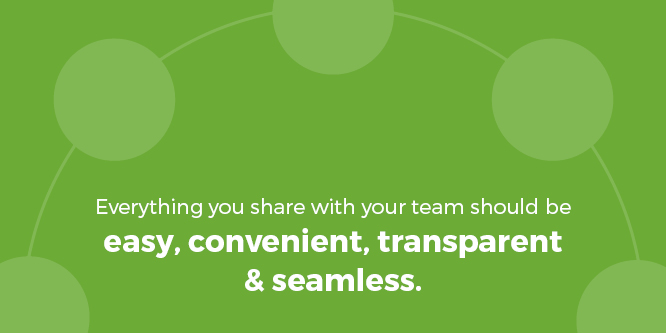
Data and insights must be both shared and understood throughout your organization and team, and everything shared should also be easy, convenient, transparent, and seamless. Marketing and analytics teams often handle most of the collected data and systems, but they may not be able to translate the information they’re looking at. That’s because their knowledge is limited, especially when applied to other departments. And misinterpretation of a dataset can often be just as bad as poor data. The only way to cut down on this is to ensure that all departments throughout your organization collaborate and work together to both translate and make use of your digital assets.
This will result in better, more engaging customer experiences and more actionable decisions and movements within your organization. Before you can explore how to share data within your organization, you must first understand why.
Why Sharing Data Between Departments Is Important
The data you collect is going to be diverse, varied, and in its raw form may be difficult to translate for certain parties within your organization or members of your team. But that does not mean it won’t be useful to them, if they can understand what it’s telling them.
More importantly, you – or the parties in charge of said data – may not have the knowledge, skills, or experience to decide how relevant something may be to the rest of your organization. The truth is that there’s no way for data analysts and facilitators to know everything.
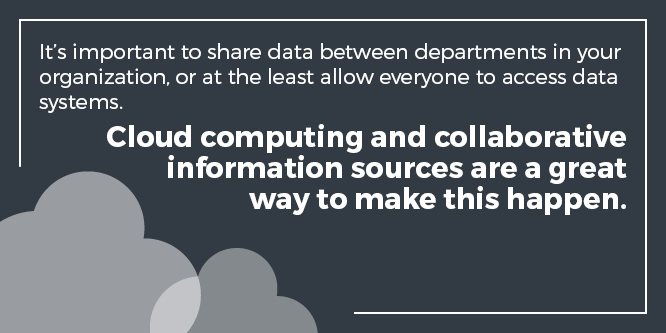
The most natural way to handle this is to share data between departments in your organization, or at the least allow everyone to access data systems. Cloud computing and collaborative information sources are great ways to make this happen. Lotame’s Data Management Platform, for instance, allows you to easily share reports and collected data with others in your organization. A DMP gathers data from multiple sources and aggregates it into one platform, then turns this data into audience profile reports so you can learn more about who your most valuable customers may be, and what makes them tick. It turns meaningless data into actionable insights you can share with marketing, sales, or even your executive teams.
The Power of Data Sharing Within an Organization
Data is, hands down, one of the most powerful, yet most misunderstood factors of social and customer-based problem solving. However, too many data owners get wrapped up in the semantics of data as a marketing tool, worrying about costs, value, and the survival of their thriving business. The data sharing definition should, in essence, retain simplicity. It is the concept of sharing vital information, details, stats, or insights across departments to create a more efficient organization.
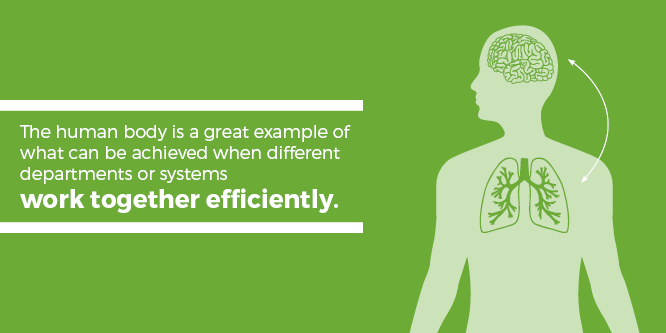
The human body is a great example of what can be achieved when different departments or systems work together efficiently. The brain tells the rest of the body what to do. Basic organs keep the body alive and active, such as the heart, lungs, and even the stomach. But no matter what is happening around a person, their brain is constantly taking in information and data, assessing what’s been collected and then using that to make a decision or carry out an action. Even something as simple as moving out of the way of an oncoming baseball or vehicle requires data, analysis, and deployment – just in a more natural form. In the case of data sharing, your business or organization is the body, and the various departments are the organs and limbs.
[bctt tweet=”A data-driven organization is filled with a workforce that uses data, information & skills to make more informed decisions & interactions.” username=”Lotame”]
When used appropriately, data has the potential to transform your entire organization. That’s why it’s incredibly important that you adapt your systems so that they are data-driven. A data-driven organization is filled with a workforce that uses data, information, and skills to make more informed decisions and interactions. But it’s not just about creating or passing around reports and forecasts. The end goal is to get helpful data into the hands of decision makers, executives, and management teams. They need the power and knowledge to explore said data independently – or collaboratively – concerning disparate data sources, raw or organized. Ideally, they are seeing the latter — more organized data and information sharing benefits that will help them to be more efficient and productive.
Sharing data in an organization, even an external one, can be incredibly beneficial for all parties involved.
Which Organizational Departments Typically Use Data?
When sharing data across an organization or team, the question ultimately becomes, what departments need access to a large amount of the data? How will they utilize it, and is providing access a primary concern or not?
When it comes to data-driven marketing efforts, the two major departments that rely most heavily on audience data are marketing and ad ops.
Marketing
The foundation of marketing is knowledge — information to make informed decisions, forecasts and predictions, and improve future campaigns. Simply put, without actionable and intelligent data in marketing, you’re dead in the water. You need information and information is power, at least when it comes to building an appropriate campaign and ensuring that campaign succeeds with your customer base.

Data is crucial to building data-driven and successful marketing strategies. Furthermore, a marketing team must understand their audience inside and out. They need to know what consumers want, what needs and expectations they have, how they will react to a decision or change and even how supportive they will be.
In content marketing, for example, the goal is to hone in on the content and materials your audience is interested in most, but also resonates with. This will drive them to action and entice them to do whatever it is you want them to do, whether that be subscribing to a newsletter, making a purchase, or reaching out for more details. If you just churn out random content with little to no thought behind it, you’re going to find most of your resources, revenue, and impact diminished over time. As in any industry, you really to make effective use of your assets — people-based or otherwise. Creative teams like writers, designers, artists, and developers need direction, most of which can be presented in the form of data.
Any and all data you collect is a means to an end. You can roll insights and patterns back into your marketing plan, further bolstering future strategies. And this is done through a DMP or data management platform, which provides you with a full view of your audience, anonymously. DMPs also give marketers the ability to send targeted messages to specific audiences. Rather than using the “spray and pray” tactic, where you send your ads out to as many people as possible and hope for a good result, targeting a certain message to one smaller group typically increases your conversion rates.
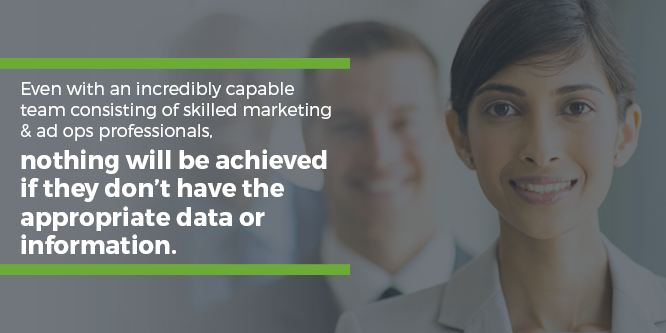
Ad Ops
At a publishing company that relies on selling ad space for revenue, Ad Operations teams, or Ad Ops, are responsible for running, activating, and maintaining advertising operations. Their primary focus is to keep advertisers happy, by managing the ad campaigns, optimizing the campaigns for increased performance, and delivering them in full. They are the lifeblood or pulse of the data-driven advertising system. Why? Because they are tasked with carrying out the goals of advertisers to reach a certain audience. Their work ensures that an advertiser is getting a suitable or acceptable return on investment, which facilitates repeat business and brand loyalty.
Other departments or team members may have some great ideas for adverts and promotional content, but they may not necessarily know what performs well. Furthermore, they may not be able to highlight or adapt an existing plan to meet the needs of an audience. Ad Ops teams are the ones who fix that. After all, you don’t want to run a banner ad and charge an advertiser for it, if there are no clicks, engagements or interest. Your advertiser will be disappointed and they probably won’t come back in the future. They may share their experience with others in the industry too, which is just as bad. This could affect your bottom line.
Ad Ops ensure success through audience targeting, implementing it as a core process of the advertising campaign. They use their knowledge, skills, and experience to boost the performance of an ad. Rather than simply deploying a single ad and showing it across the breadth of a site, they can send targeted promotions to the relevant portals. For example, they can send a targeted sports-related ad to specific audiences who have previously shown an interest in sports material. Overall, this helps increase engagement, performance, and value of a campaign.
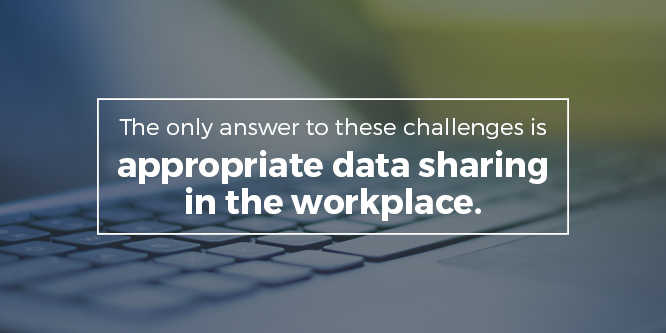
Which Organizational Departments Can Benefit from Shared Data?
Along with marketing and ad ops, many other departments including sales, fulfillment, shipping, customer support, and more – need data to succeed. Each department needs a fresh source of data in real-time, which they are constantly reviewing, analyzing, and interpreting. However, many other departments require data but can benefit from shared or collaborative systems. If you truly want to define data sharing, you must look at how incoming information is handled. The data comes in, is parsed and organized by a different group such as a marketing team, and then made available to the rest of the organization. Here is a deeper dive into some additional departments that might benefit from a steady stream of data.
[bctt tweet=”Along with marketing and ad ops, many other departments including sales, fulfillment, shipping, customer support – need data to succeed.” username=”Lotame”]
Design
Design can be broken down into smaller categories, all of which have to do with collecting and analyzing audience data. All boil down to one remarkably simple concept: what do the consumers want?
By relying on historical trends, and performance data, organizations can come up with better content or products, giving customers what they want and boosting the bottom line.
- User Experience Info: By tapping into user performance metrics like bounce rates, engagement, clicks, traffic, and even popular content and products, designers can better serve their customer base.
- Conversion Information: Want to increase your customer conversion rate? Use historical insights to pinpoint why customers converted in the past, and how you can apply that to future campaigns.
- Usability: Site and app usability is a major concern for consumers, as they will abandon ship if they encounter a poor experience. You can use insights to improve existing experiences and build better ones.
- Development: Development is costly. How can you be sure you’re building the right tools, software, apps or services? By looking at development data for past projects and matching them with performance metrics.
- Operating Systems: What operating systems are best? What OS is the most popular among your user base? How can you be sure your largest demographic will be supported? Relevant data helps provide answers to these questions.
- Devices: Smartphones, tablets, netbooks, laptops, desktop, wearables, game consoles, smart TVs, and on and on. There are so many platforms and devices your user base can be viewing from, and you need data to discern the most viable ones.
- Browser Size: When a customer lands on a site or portal, the system is designed to discern their current device, resolution, and browser size. They are then served a UI or layout best suited for their current experience. This is only possible through data.
Sales
In the publishing world, sales teams work hand in hand with Ad Ops, and are concerned with selling advertising space to a variety of advertisers. They work closely with Ad Ops to ensure that the campaign goals are met so that their advertisers remain happy customers.
Sales team members use audience targeting to appease their advertising clients. When a new client reaches out to the sales team, for instance, they can provide clear stats and examples, which work like case studies or testimonials when it comes to talking up the potential client.
More importantly, they can make informed promises to potential partners by assuring and informing on a niche audience. They might assure potential partners by making statements such as, “Your product advertisement would absolutely work best with this audience over here, netting X amount in value.”
Their primary concern is how they can best reach an advertisers’ targets. The only suitable answer to these challenges is the appropriate data and information sharing in the workplace.
Editorial and Production Department
Content marketing – like any form of business – requires a well-oiled machine working in tandem with other machines and operating efficiently in order to achieve success. In the case of editorial, creative, and production departments, they can rely on insights and data to produce more engaging, higher-value materials. If they know what their audience is most interested in, they can tailor content to meet those demands.
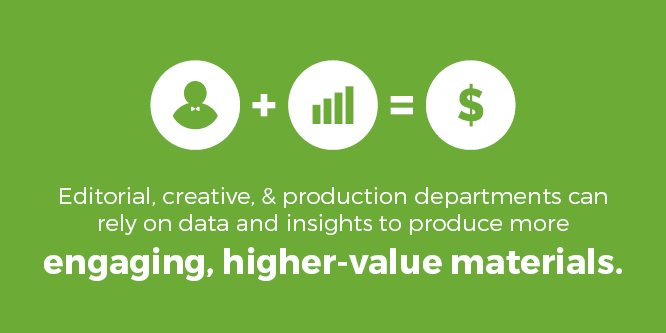
A more innovative approach to this relies on a direct sync between a DMP and CMS or content management system. You can use incoming data and real-time insights to make changes on promoted content and topics. This has a dual-edge effect. It keeps customers on site longer and increases engagement ratings across the board. Of course, using real-time data can also help decrease bounce rates, which is a huge deal in the world of content marketing. The more people you keep on your site, browsing your site, and sorting through your portal, the more money you’re going to make.
There’s also the advertising side of the production world. All improvements made through the aforementioned data will contribute to better, more versatile, and more efficient advertising opportunities. This will make more money for advertisers and publishers, and increase brand reputation.
Executives and C-Suite Professionals
Executives, project managers, and higher-ups like C-Suite professionals can rely on data to make more informed decisions and steer the company in a more positive direction. Imagine what can happen when you use financial and sales data to incorporate an effective budget?
[bctt tweet=”Executives, project managers, and higher-ups like C-Suite professionals can rely on data to make more informed decisions.” username=”Lotame”]
Executives can also tap into audience data to achieve similar results. When making decisions on new or old products, for instance, they can look at the current customer climate, forecasts, and even series or model history. You have tons of audience and customer data. Most data-driven companies do. You might as well put it to work for you.
Finance
The finance team can effectively use data to increase a company or organization’s bottom line. There’s the internal side of things, where they can use collected data to boost and improve company policies and procedures. But there’s also an external aspect to it. They can take data and sell it via a third-party data exchange or second-party relationship. They package and bundle up insights and sell them to the highest, most lucrative bidders. It’s an added form of revenue for a data-driven company, especially one so focused on digital assets.
Of course, this has the added benefit of boosting the efficiency of advertising buys. Through collaborative efforts with a proper ad ops team, finance can ensure they are sending ads to the most lucrative and valuable customers; further increasing the chance of repeat business.
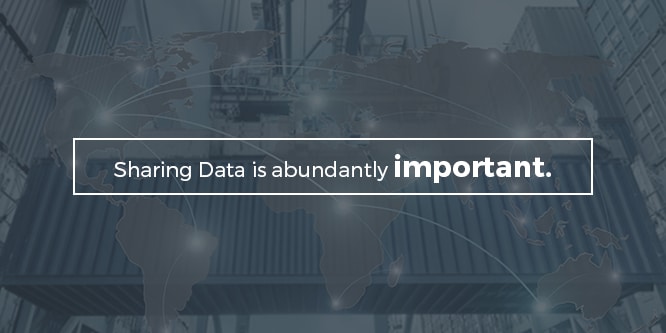
Data Is for Everyone
For data-driven companies or data-centric teams, you’ll often see the same policies and procedures put into place, blanketing the same few departments. Marketing and Ad Ops come to mind as the most important and first departments that see data and analytics. But with the right DMP or data management platform, the information you’re collecting from your audience can be so much more. It can open up so many new opportunities and serve so many different departments in your organization that it’s hard to comprehend.
The modern DMP and supported systems should evolve to include more areas of an organization than we currently see. It’s about time we take it outside just marketing and advertising departments and really dig into the data and insights we’re collecting.
By reviewing this guide, you now have a better understanding of what cross-organizational data can be used for, and why sharing data is abundantly important in today’s market.
If your company is ready to step up its data-sharing procedures, we hope you’ll consider using Lotame’s data management solutions. Browse our products today.
